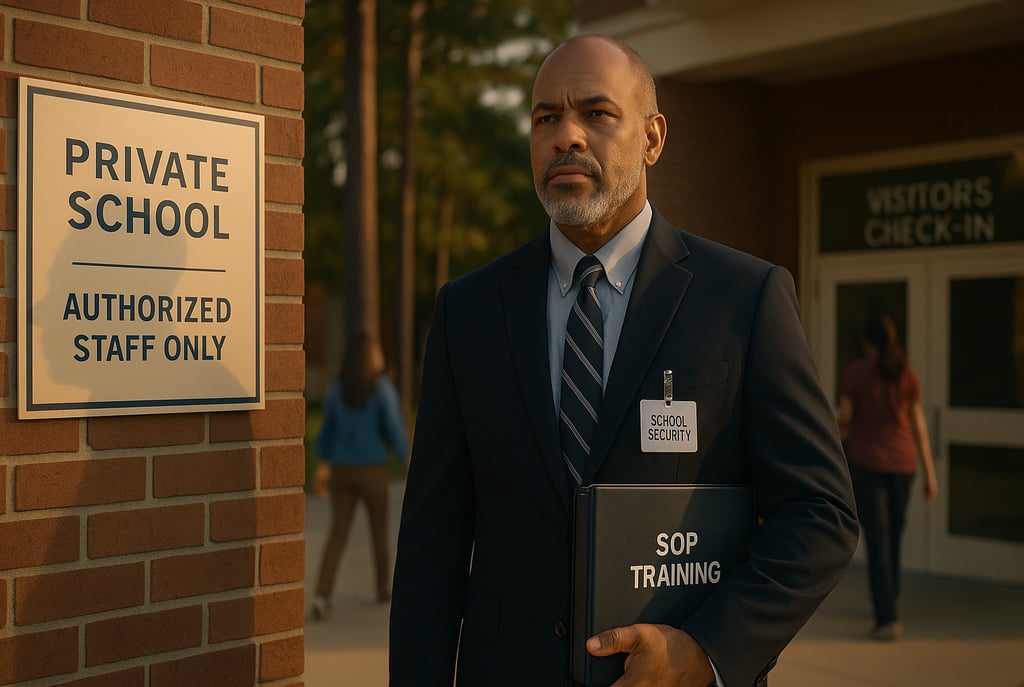North Carolina private school security training
Clear, practical guide to North Carolina private school security training: who can be authorized, CHP + annual 8-hour (NRA or equivalent) requirement, written SOPs with annual parent notice, and worship-campus carry rules—plus a checklist to launch a compliant program.
John Boyette
8/10/20253 min read


North Carolina has updated its firearms laws to let nonpublic K–12 schools authorize vetted employees and volunteers to carry on campus—under strict guardrails. If you’re on a school board of trustees or you lead a faith-based school, here’s how the law works and how to build a compliant, defensible training program. (NC General Assembly Webservices)
What the new law allows (and when)
Session Law 2025-81 (House Bill 193) amends G.S. 14-269.2 to create a narrow exemption for employees or volunteers of a nonpublic school who are formally authorized in writing by the school board of trustees or school administrative director to possess and carry a firearm or stun gun on school property. The statute also refines carry rules for religious-school campuses, preserving the general ban during school hours but allowing concealed carry by permit holders inside the worship building while attending specified religious functions, with property-owner opt-out via posted signage. (NC General Assembly Webservices, North Carolina General Assembly)
Minimum requirements you must meet
Written authorization from the governing body/administrative director. (NC General Assembly Webservices)
A valid concealed handgun permit under Article 54B. (NC General Assembly Webservices)
Annual training: at least 8 hours of additional firearms coursework under the direct supervision of a certified NRA instructor (or equivalent)—above and beyond CHP training. (NC General Assembly Webservices)
SOPs & parent notice: the school must adopt written standard operating procedures governing carry and distribute them to parents annually. (NC General Assembly Webservices)
On-premises limitation: authorization applies only while the individual is on the premises of the same nonpublic school. (NC General Assembly Webservices)
Note: For shared church-school campuses, “place of religious worship” is defined separately in G.S. 14-54.1 (church, chapel, synagogue, temple, etc.), which the amended G.S. 14-269.2(k1) cross-references. (North Carolina General Assembly)
Building a compliant training program
Map policy to statute. Your SOPs should mirror the statute’s elements: eligibility, authorization workflow, weapons policy (handgun vs. stun gun), storage/transport rules, documentation, and annual re-authorization. Include a parent-notification schedule and record distribution annually. (NC General Assembly Webservices)
Validate credentials. Maintain copies of each participant’s CHP and your board’s written authorization. Track expirations and renewals in a simple compliance log. (NC General Assembly Webservices)
Exceed the 8-hour baseline. The law sets a floor, not a ceiling. Layer in force-on-force decision-making, medical response (CPR/AED), weapons retention, and after-action reporting. When you use NRA-certified instructors or equivalent, keep rosters, curricula, and certificates on file. (firearmtraining.nra.org)
Coordinate with worship leadership. For campuses that include a worship building, align your schedule and signage with G.S. 14-269.2(k1) (owner-posted signs control). Train teams on ingress/egress between worship buildings and designated parking. (North Carolina General Assembly)
Why work with a North Carolina–based provider
Trace Armory Group brings 15+ years of North Carolina firearms-training experience, including NRA Certified Firearms Instructor credentials (since 2006), use-of-force instruction, and a track record of teaching 2,000+ students since 2010. Our mission is to empower families and institutions with practical, standards-driven training—exactly what private schools need to meet today’s compliance expectations. (Trace Armory Group)
We’ve also been recognized locally for elevating safety education across the Sandhills, including curriculum development and peer-to-peer coaching for other instructors—experience we translate into school-specific SOPs, drills, and documentation checklists. (Sandhills Sentinel)
Core modules we recommend (beyond the legal minimum)
Policy-First Orientation: statute overview; roles of the board of trustees and administrative director; documentation and audit readiness. (NC General Assembly Webservices)
Defensive Handgun Fundamentals: safety, handling, marksmanship, ready positions, and presentation under time standards.
Decision-Making & De-escalation: proportionality, accountability, and post-incident protocols aligned with North Carolina use-of-force law.
Weapons Retention & Movement: hallway/doorway problems, third-party proximity, and communication with 911/first responders.
Medical Response Integration: CPR/AED and bleeding control to stabilize until EMS arrives.
Tabletop + Live Drills: SOP walk-throughs, radio procedures, and graded qualifications that create an objective paper trail.
Implementation checklist for school leaders
Approve and publish SOPs; schedule annual parent distribution. (NC General Assembly Webservices)
Select vetted personnel; issue written authorizations and maintain secure records. (NC General Assembly Webservices)
Verify CHP status for each authorized person, then calendar annual 8-hour refreshers with an NRA-certified instructor or equivalent. (NC General Assembly Webservices, firearmtraining.nra.org)
Coordinate with the worship ministry on signage and on when/where carry is permitted under (k1) for services and other sacerdotal functions. (North Carolina General Assembly)
This article is educational and not legal advice. Consult counsel for campus-specific decisions.
Next step: If you’re a North Carolina private or faith-based school ready to stand up a compliant security-team program, Trace Armory Group can help with board training, SOP drafting, and state-aligned annual firearms training. Book a consult today. (Trace Armory Group)
